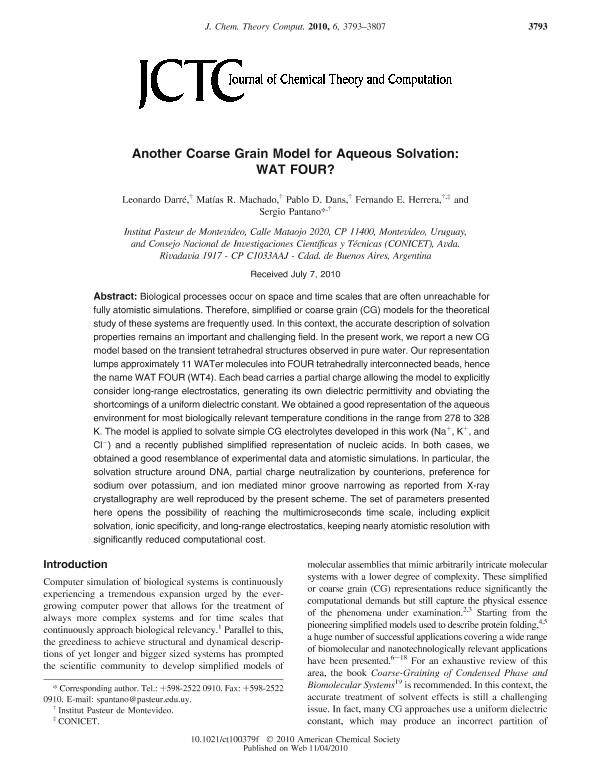Mostrar el registro sencillo del ítem
dc.contributor.author
Darre, Leonardo
dc.contributor.author
Machado, Matías
dc.contributor.author
Dans, Pablo
dc.contributor.author
Herrera, Fernando Enrique

dc.contributor.author
Pantano, Sergio
dc.date.available
2020-03-31T14:17:47Z
dc.date.issued
2010-11
dc.identifier.citation
Darre, Leonardo; Machado, Matías; Dans, Pablo; Herrera, Fernando Enrique; Pantano, Sergio; Another Coarse Grain Model for Aqueous Solvation: WAT FOUR?; American Chemical Society; Journal of Chemical Theory and Computation; 6; 12; 11-2010; 3793-3807
dc.identifier.issn
1549-9618
dc.identifier.uri
http://hdl.handle.net/11336/101433
dc.description.abstract
Biological processes occur on space and time scales that are often unreachable for fully atomistic simulations. Therefore, simplified or coarse grain (CG) models for the theoretical study of these systems are frequently used. In this context, the accurate description of solvation properties remains an important and challenging field. In the present work, we report a new CG model based on the transient tetrahedral structures observed in pure water. Our representation lumps approximately 11 WATer molecules into FOUR tetrahedrally interconnected beads, hence the name WAT FOUR (WT4). Each bead carries a partial charge allowing the model to explicitly consider long-range electrostatics, generating its own dielectric permittivity and obviating the shortcomings of a uniform dielectric constant. We obtained a good representation of the aqueous environment for most biologically relevant temperature conditions in the range from 278 to 328 K. The model is applied to solvate simple CG electrolytes developed in this work (Na+, K+, and Cl-) and a recently published simplified representation of nucleic acids. In both cases, we obtained a good resemblance of experimental data and atomistic simulations. In particular, the solvation structure around DNA, partial charge neutralization by counterions, preference for sodium over potassium, and ion mediated minor groove narrowing as reported from X-raycrystallography are well reproduced by the present scheme. The set of parameters presented here opens the possibility of reaching the multimicroseconds time scale, including explicit solvation, ionic specificity, and long-range electrostatics, keeping nearly atomistic resolution with significantly reduced computational cost.
dc.format
application/pdf
dc.language.iso
eng
dc.publisher
American Chemical Society

dc.rights
info:eu-repo/semantics/openAccess
dc.rights.uri
https://creativecommons.org/licenses/by-nc-sa/2.5/ar/
dc.subject
WATER
dc.subject
MODEL
dc.subject
COARSE
dc.subject
GRAIN
dc.subject.classification
Biofísica

dc.subject.classification
Ciencias Biológicas

dc.subject.classification
CIENCIAS NATURALES Y EXACTAS

dc.title
Another Coarse Grain Model for Aqueous Solvation: WAT FOUR?
dc.type
info:eu-repo/semantics/article
dc.type
info:ar-repo/semantics/artículo
dc.type
info:eu-repo/semantics/publishedVersion
dc.date.updated
2020-03-27T13:42:05Z
dc.journal.volume
6
dc.journal.number
12
dc.journal.pagination
3793-3807
dc.journal.pais
Estados Unidos

dc.description.fil
Fil: Darre, Leonardo. Instituto Pasteur de Montevideo; Uruguay
dc.description.fil
Fil: Machado, Matías. Instituto Pasteur de Montevideo; Uruguay
dc.description.fil
Fil: Dans, Pablo. Instituto Pasteur de Montevideo; Uruguay
dc.description.fil
Fil: Herrera, Fernando Enrique. Universidad Nacional del Litoral; Argentina
dc.description.fil
Fil: Pantano, Sergio. Instituto Pasteur de Montevideo; Uruguay
dc.journal.title
Journal of Chemical Theory and Computation

dc.relation.alternativeid
info:eu-repo/semantics/altIdentifier/doi/http://dx.doi.org/10.1021/ct100379f
Archivos asociados
